Notes
What’s Distinguishing and What’s Familiar in the Post-Coup Protest Pictures from Myanmar
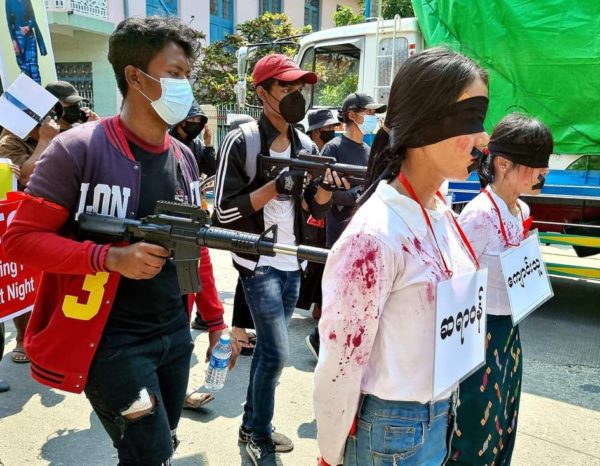
Photo: FB Messenger sent to JG Caption: Protest in Mawlamyine, February 17, 2021.
Two blindfolded women with black tape crisscrossed on their mouths and red splatters on their shirts walk in front of two men holding rifles at their backs.
Unsettling as it appears at first, the English lettering on the young man’s tee-shirt, like his ripped jeans and his companion’s red baseball cap, hints that this is not what it seems. Instead, these young Burmese protesters are enacting a violent police arrest as part of nation-wide protests and labor strikes against the 3-week old military coup that led to the detention of Daw Aung San Sue Kyi and other leaders of the National League for Democracy (NLD), as well as artists, writers, reporters and scores of others.
Reenacting violent arrests broadcasts that which the junta hopes to keep hidden from global eyes and, wittingly or not, portends an ominous and all-too imminent future.
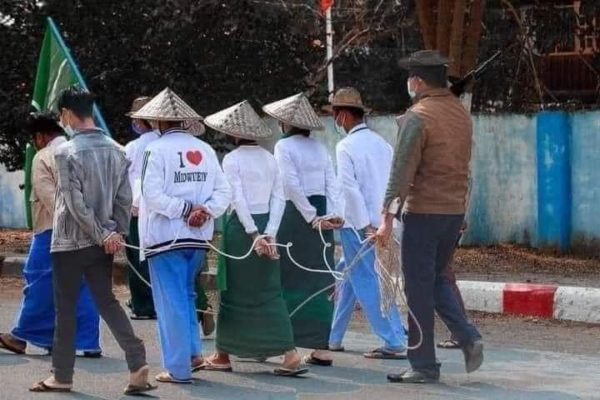
Photo: via FB messenger sent to JG. Caption: Arrests in Mandalay, February 20, 2021.
This photograph taken three days later shows five people with their hands tied behind their backs being directed by a man with a rifle. No street theater this time; this is one of many photographs sent by Facebook messenger to friends outside of the country, calling out for world-wide attention to the violent crackdown by the junta.
The NLD won in an overwhelming landslide in Myanmar’s national elections on November 8, 2020. Shortly thereafter the military powers in the country – who held onto significant power even after 2015 when the country began its fragile shift to democracy– started making noise about election fraud and voter irregularities. In the pre-dawn hours of February 1 in the capital, Nay Pyi Daw, they enacted a coup, “detaining” NLD leaders, and declaring the newly elected parliament void. Two of the women being arrested wear the country’s public school uniforms of green skirts and white tops.
Despite the junta’s attempts at censorship, including limiting access to the Internet, citizens in Myanmar are using social media to visualize the extent and creativity of the Civil Disobedience Movement (CDM).
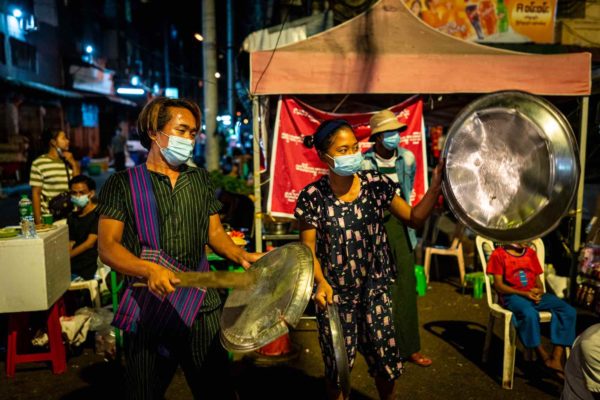
Photo: Stringer/Getty Images. Caption: People beat metal utensils to make noise in protest on February 04, 2021, in Yangon, Myanmar. In the days after the military coup against the elected government of de-facto leader Aung San Suu Kyi and her National League of Democracy party, Myanmar people have been taking to the streets at night to bang utensils and metal items in a noisy campaign to make their unhappiness at with the military junta’s actions known.
Photographs circulating across regional and international platforms show low-tech strategies such as the nightly occurrence of people banging pots outside their homes and shops.
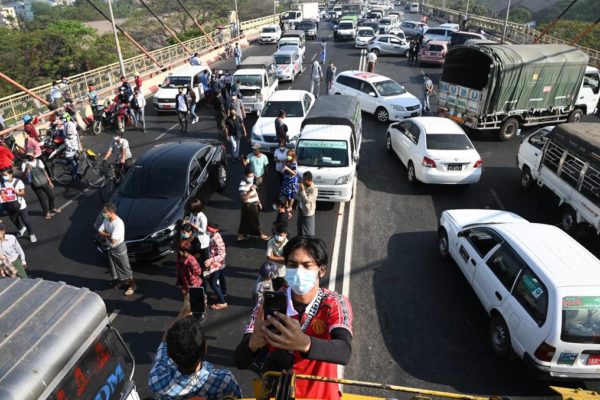
Photo: AFP Caption: Protesters block a bridge with their cars during a demonstration against the military coup in Yangon, Myanmar. February 18, 2021.
Here the young man in the foreground takes a selfie that helps to visualize the ordinary locations where protesters are challenging the coup.
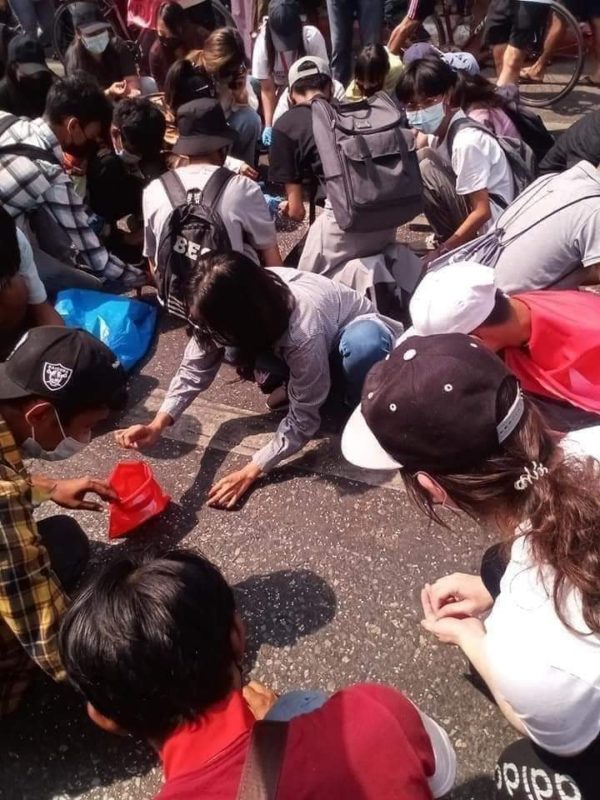
Photo: FB Messenger sent to JG Caption: “Counting rice campaign on the road”, Yangon, February 19, 2021.
Using their bodies, literally putting themselves in the middle of the street, people in this photograph block traffic as they crouch down to pick up spilt rice grains. Bags of rice, the main dietary staple in Myanmar, are dropped and spread in order to symbolize the scope of the protest movement.
Meanwhile, placards, banners, and painted street signs, often in English, declare their objectives to international audiences. A road with “WE WANT DEMOCRACY” painted in massive letters, for instance, features a young person dipping a hand into a bucket of white paint in the foreground while stretching out behind him, others fill in the massive letters.
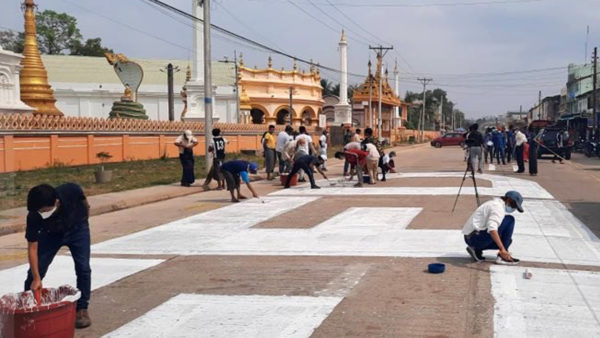
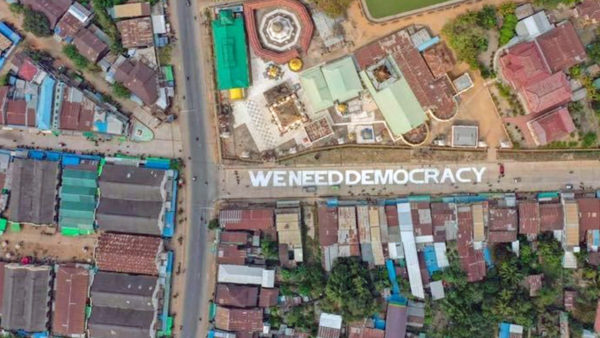
Photos: RFA Burmese Caption: Bago Division Pyay District Generation Z’s anti-military movement in Paungde was seen.
Painting slogans on major urban boulevards is reminiscent of tactics used by Black Lives Matter activists last summer. No longer an isolated nation, people in Myanmar, and particularly young people use social media to connect with the cultures, attitudes, and practices of a wider world.
Nowhere is this more evident than in the CDM’s three-finger salute. First made famous in The Hunger Games, three fingers raised to the camera represent for the Myanmar people a strong gesture of defiance.
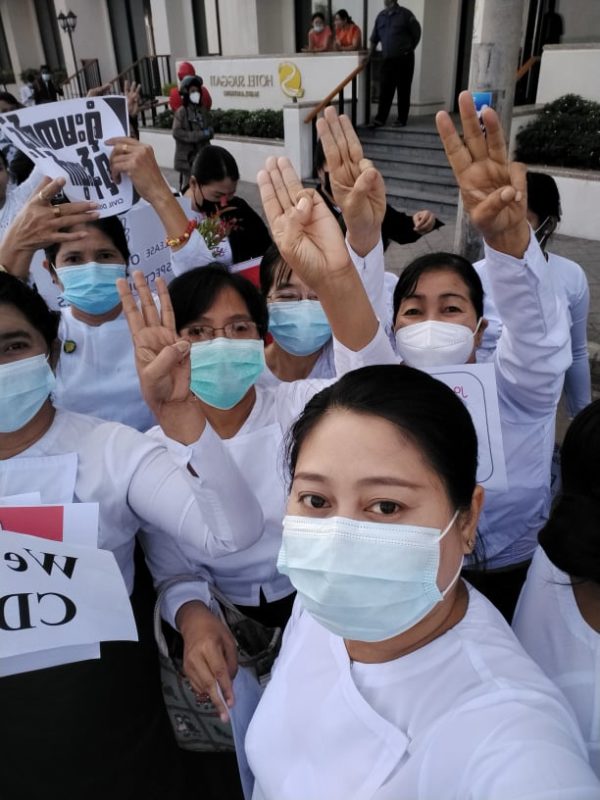
Photo: FB Messenger sent to JG Caption: Schoolteachers from Mawlamyine, February 9, 2021.
Friends in Myanmar have been sending Jessica images of protest for weeks, and more recently, also scenes of the crackdown by the military. Jessica Grim, the co-author of this post, was in the Peace Corps in Myanmar until she was evacuated last spring because of Covid. Teachers with whom she worked for 14 months as a Peace Corps volunteer in 2019-20 sent this selfie of themselves in their school uniforms raising the three-finger salute.
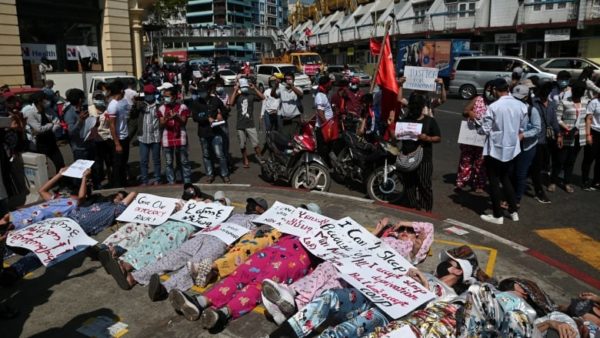
Photo: Reuters Caption: People display placards as they rally against the military coup and to demand the release of elected leader Aung San Suu Kyi, in Yangon, Myanmar, February 20, 2021.
The women lying on the pavement wearing pajamas in this photo are not simply protesting the coup; they are commenting on the nearly complete disruption that the coup has caused in their daily lives. One placard reads “I accept sleep deprivation but I don’t accept coup.”
Fear of nightly arrests by the military, as well as possible break-ins and violence from the large population of newly freed prisoners, makes sleep nearly impossible. Much like the street painting, the “sleep-ins” draw influences from the die-in tactics used by BLM protesters.
Across this growing archive of protest culture, iconic symbols like the three-finger salute and English-language placards urging the US to intervene convey hopes and expectations on the part of the people born of Myanmar’s “taste” of democracy.
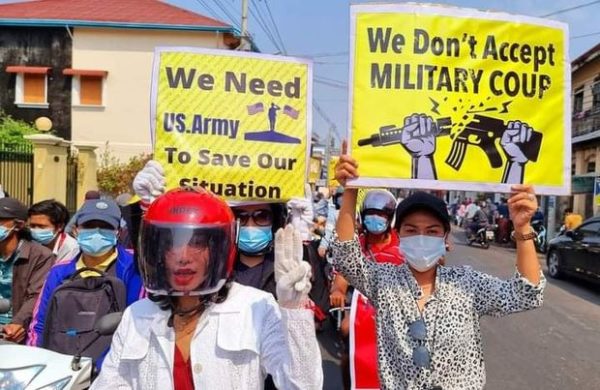
Photo: FB Messenger sent to JG Caption: Protesters in Mawlamyine, February 18, 2021.
Yet, even as outside countries have repeatedly urged the military dictators not to turn on their people with violence – and warned that “the world is watching” – the junta has not been able to resist.
Photographs from the largest cities like Yangon and Mandalay to smaller towns and villages are increasingly featuring arrests, water cannons, bullets both rubber, and “real” – and fatalities. Early in the protest movement, a 20-year-old woman in Mandalay was killed by a gunshot to the head. Others have been wounded. And the regular night raids on peoples’ homes – to arrest activists, artists, and leaders of the protest movement – continues.
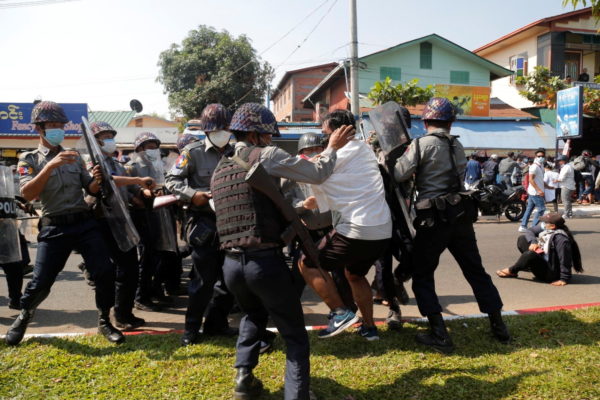
Photo: Than Lwin Times/via REUTERS Caption: A demonstrator is detained by police officers during a protest against the military coup in Mawlamyine, Myanmar, February 12, 2021.
In response to the unfolding situation in Myanmar, and as the threat of more violent crackdowns by the military seem all but inevitable, Peace Corps volunteers who served in Myanmar have collected over 300 signatures on a letter to the U.S. government urging continued efforts to help restore the democratically elected parliament.
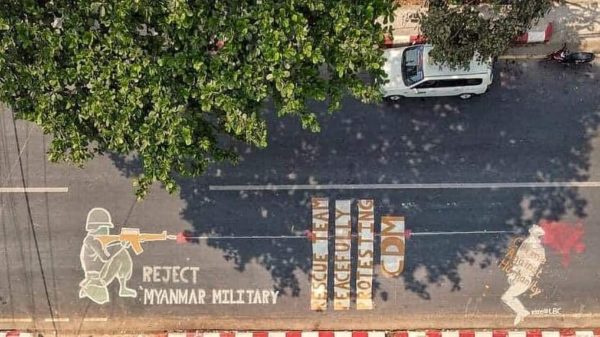
Photo: FB Messenger sent to JG Caption: Protest art in Thanlyin, February 23, 2021.
The gunfire flashes and the bloody smear, like “crimes against humanity” written across the body, dramatize the fragility of the CDM’s calls for peaceful protests.
— Jessica Grim and Wendy Kozol
Thanks to Khin Htway Myint and Mya Thiri for sharing some of the images used in this post.
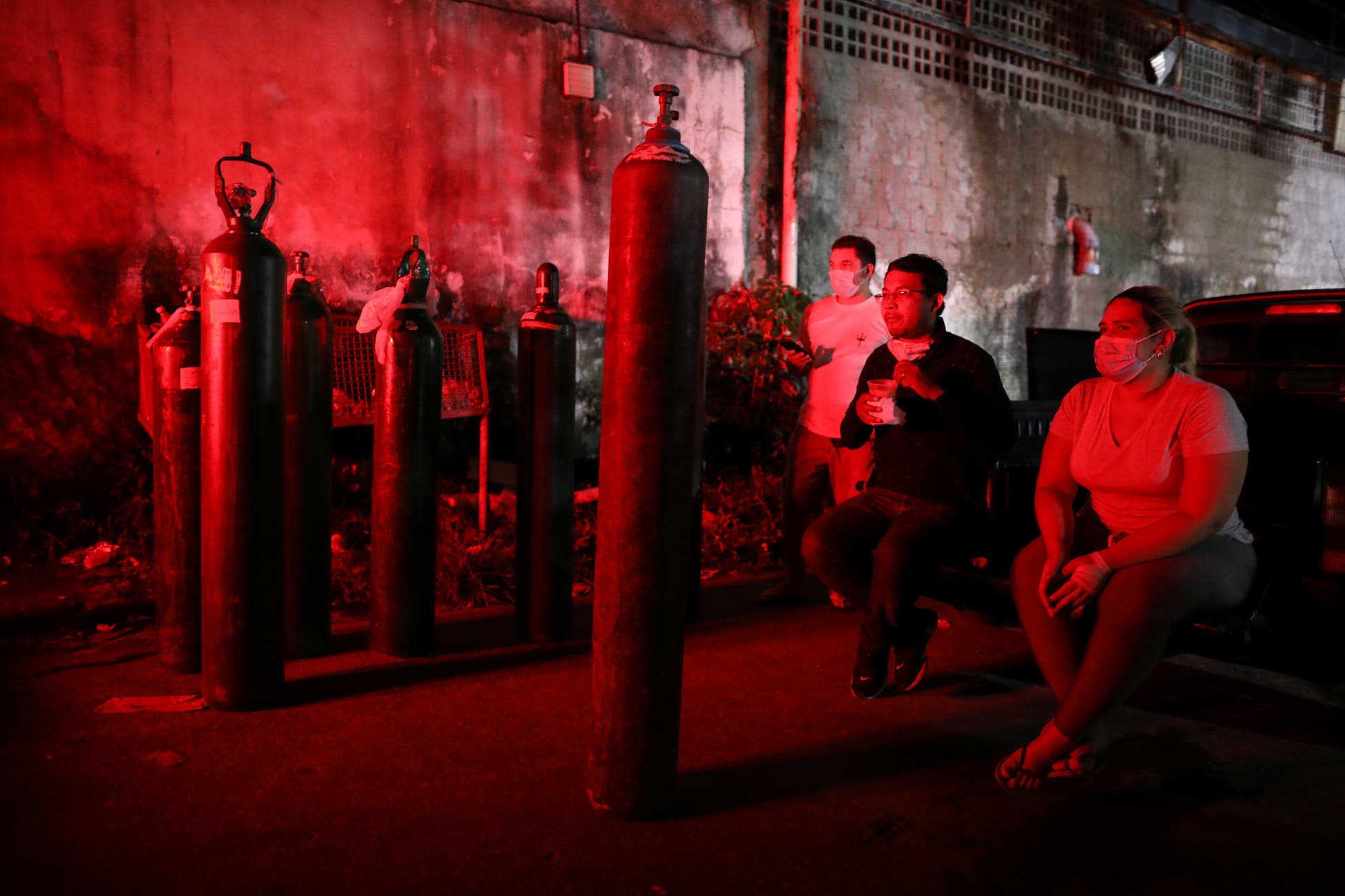
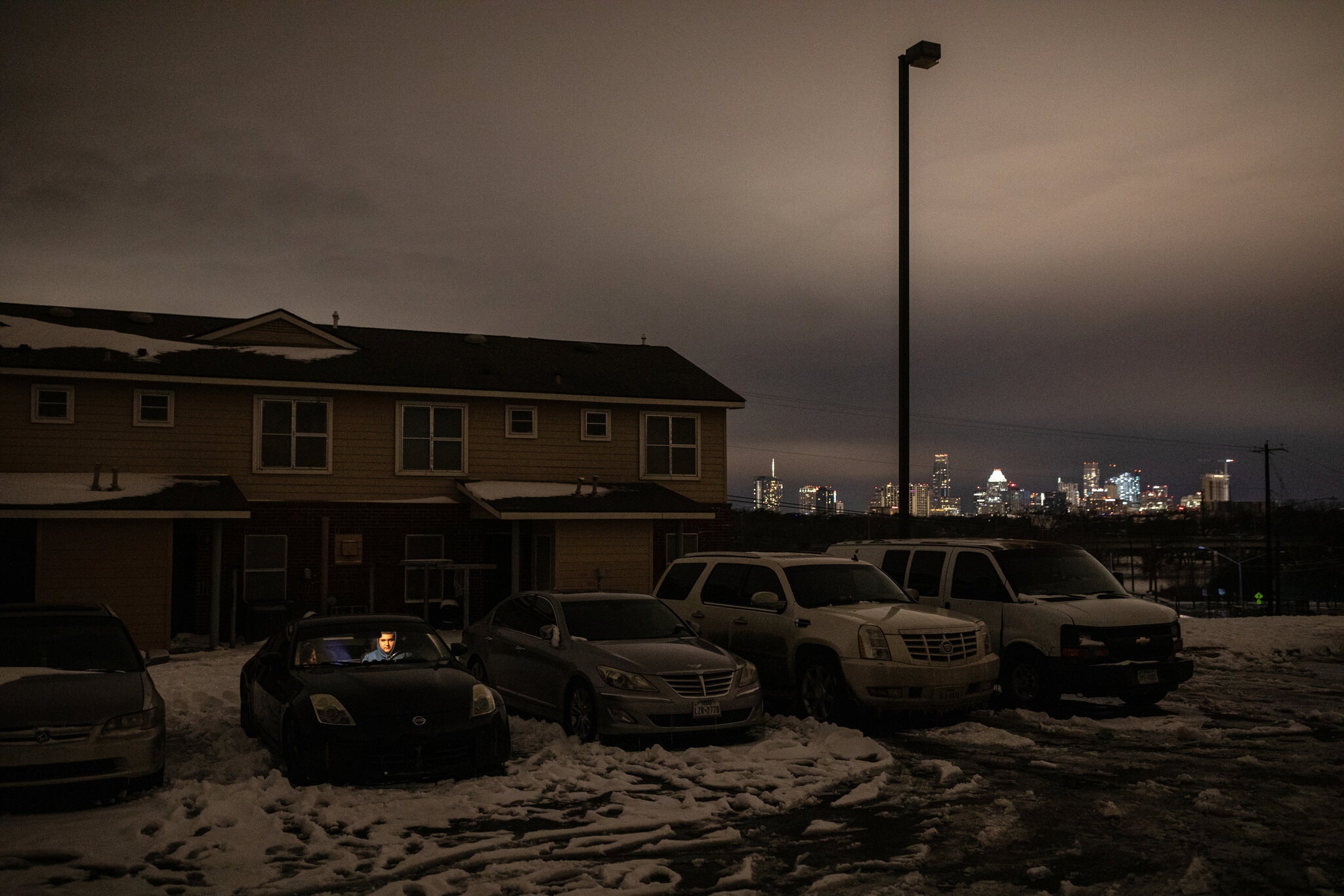
Reactions
Comments Powered by Disqus